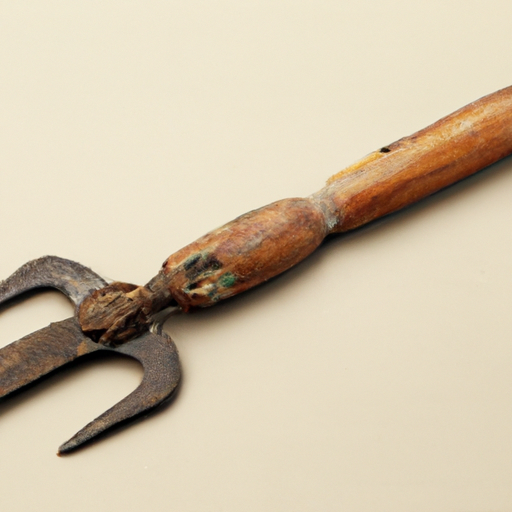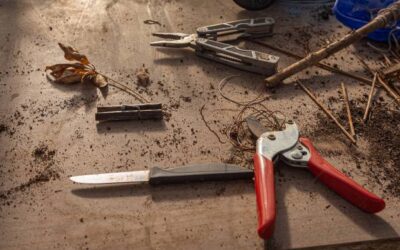In this article, you will learn about the fascinating repair culture surrounding Japanese garden tools. Japanese craftsmen have mastered the art of recycling and reusing their tools, taking great care in their maintenance and repair. By understanding this repair culture, you will gain valuable insights into the sustainability and longevity of these tools.
Japanese garden tools are renowned for their high quality and durability, but what sets them apart is the dedication to repairing and reusing them. When a tool becomes worn or damaged, instead of discarding it and buying a new one, Japanese craftsmen take the time to repair and restore it. This not only saves money but also reduces waste and contributes to the overall sustainability of their craft. By delving into the repair culture of Japanese garden tools, you will discover the mindset and techniques behind this unique approach to tool maintenance.

History of Japanese Garden Tools
Japanese garden tools have a rich history that dates back centuries. These tools are not only functional but also reflect the traditional craftsmanship and values of Japan. The evolution of Japanese garden tools is a testament to the country’s deep-rooted respect for nature and the environment.
Evolution of Japanese Garden Tools
The evolution of Japanese garden tools can be traced back to the Heian period (794-1185). During this time, Japan experienced a cultural renaissance, and gardening became a popular art form. Japanese gardeners began using a wide range of tools to create and maintain their gardens, including hoes, rakes, pruning shears, and sickles. These tools were handcrafted with great care and attention to detail, reflecting the skill and expertise of Japanese craftsmen.
Over time, Japanese garden tools evolved to meet the changing needs and techniques of gardening. For example, the introduction of Zen Buddhism in Japan during the Kamakura period (1185-1333) led to the development of the Zen garden, which required a different set of tools and techniques. Japanese gardeners adapted their tools to create the carefully raked patterns and serene landscapes that are characteristic of Zen gardens.
Introduction of Repair Culture in Japanese Garden Tool Industry
The repair culture in the Japanese garden tool industry emerged as a response to the need for sustainable practices and the preservation of traditional craftsmanship. Instead of discarding broken or worn-out tools, Japanese gardeners saw an opportunity to recycle and reuse these tools by repairing them. This mindset led to the establishment of repair workshops and the development of training programs for repair experts.
Importance of Repair Culture
The repair culture of Japanese garden tools is not only about fixing broken tools but also about preserving traditional craftsmanship and promoting sustainable practices in gardening.
Preserving Traditional Craftsmanship
Japanese garden tools are known for their high-quality craftsmanship and durability. Each tool is meticulously made by skilled craftsmen who have spent years learning their craft. By repairing and preserving these tools, the repair culture ensures that the knowledge and techniques of these craftsmen are passed down to future generations. This commitment to traditional craftsmanship is what sets Japanese garden tools apart from mass-produced tools and contributes to their longevity.
Sustainable Approach to Gardening
In a world where consumerism and disposable culture are increasingly prevalent, the repair culture of Japanese garden tools offers a sustainable alternative. Rather than buying new tools every time a repair is needed, gardeners can extend the lifespan of their tools through repairs. This reduces waste and the environmental impact associated with the production and disposal of new tools. The repair culture encourages gardeners to think critically about their consumption habits and take responsibility for the tools they use.
Cost-Effective Solution for Gardeners
Repairing garden tools is not only sustainable but also cost-effective. By repairing tools instead of buying new ones, gardeners can save money in the long run. Repair workshops and training programs further contribute to cost savings by offering affordable repair services and teaching gardeners how to perform basic repairs themselves. The repair culture provides an accessible solution for gardeners of all levels of expertise and financial means.
Communities of Repair Experts
The establishment of repair workshops and the development of training programs have brought together a community of repair experts dedicated to preserving and enhancing the repair culture of Japanese garden tools.
Establishment of Repair Workshops
Repair workshops have become a hub for repair experts to share their knowledge and skills. These workshops offer a space for gardeners to bring their broken or worn-out tools and have them repaired by experts. The workshops also serve as a platform for experts to collaborate, exchange ideas, and develop innovative repair techniques. The sense of community fostered in these workshops contributes to the growth and sustainability of the repair culture.
Training Programs for Repair Experts
To ensure the continuation of the repair culture, training programs have been introduced to educate a new generation of repair experts. These programs teach participants the traditional repair techniques and equip them with the specialized tools needed for repairing garden tools. By passing on their knowledge and skills, experienced repair experts contribute to the growth and preservation of the repair culture.
Repair Techniques and Tools
Repairing Japanese garden tools requires specialized techniques and tools that have been developed and refined over time.
Traditional Repair Techniques
Traditional repair techniques involve carefully disassembling the tool, identifying the damaged or worn-out parts, and either repairing or replacing them. The repair experts use traditional methods such as forging, welding, and sharpening to restore the functionality and durability of the tools. These techniques require precision and attention to detail, reflecting the craftsmanship that went into making the tools in the first place.
Specialized Tools for Repairing Garden Tools
Repairing Japanese garden tools requires specialized tools that are designed for specific tasks. These tools are often handcrafted by skilled artisans, ensuring their quality and durability. Some of the specialized tools used in the repair process include hammers, chisels, files, and sharpening stones. These tools enable repair experts to perform precise and delicate repairs, ensuring that the tools are restored to their original condition.

Communication and Collaboration
The repair culture of Japanese garden tools thrives on communication and collaboration between repair experts and gardeners.
Exchange of Knowledge Among Repair Experts
Repair workshops and training programs provide opportunities for repair experts to exchange knowledge, share techniques, and learn from each other’s experiences. This open exchange of information ensures that the repair culture continues to evolve and adapt to the changing needs of gardeners. Repair experts can learn new repair techniques, discover innovative tools, and gain insights into different approaches to repairs.
Collaboration Between Repair Experts and Gardeners
Collaboration between repair experts and gardeners is essential for the repair culture to thrive. Repair experts can assist gardeners in identifying the best course of action for their tools and provide guidance on preventive maintenance. By working together, repair experts and gardeners can ensure that the repaired tools are used correctly and cared for properly, maximizing their lifespan and functionality.
Case Studies: Successful Repairs
There are numerous examples of successful repairs that highlight the effectiveness and impact of the repair culture on the longevity of Japanese garden tools.
Examples of Repaired Garden Tools
One example of a successful repair is the restoration of a worn-out pruning shear. The repair expert disassembled the shears, replaced the worn-out blade with a new one, and sharpened the cutting edge. The repair not only extended the lifespan of the shears but also improved their performance. Another example is the repair of a broken handle on a garden rake. The repair expert removed the damaged handle and replaced it with a new one, ensuring that the rake could continue to be used effectively.
Impact of Repairs on Tool Longevity
These successful repairs demonstrate the impact of the repair culture on the longevity of Japanese garden tools. By repairing and maintaining the tools, gardeners can continue to use them for many years, reducing the need to replace them with new ones. This not only saves money but also reduces waste and the environmental impact associated with the production and disposal of new tools. The repair culture promotes a more sustainable approach to gardening, where resources are conserved and tools are valued for their craftsmanship and functionality.
Challenges in Repair Culture
While the repair culture of Japanese garden tools has made significant strides, it is not without its challenges.
Availability of Spare Parts
One of the main challenges in the repair culture is the availability of spare parts for older or less common tools. As new tools enter the market and older models are phased out, finding replacement parts can become more difficult. This challenge highlights the importance of preserving traditional craftsmanship and ensuring that the knowledge and skills required to make these parts are not lost.
Shifting Preferences Towards New Tools
Another challenge is the shifting preferences of gardeners towards new tools. With the introduction of modern and more technologically advanced tools, some gardeners may opt to replace their old tools rather than repairing them. This shift in preferences poses a threat to the repair culture and the sustainable practices it promotes. However, by raising awareness about the benefits of repairs and educating gardeners about the value of traditional craftsmanship, these challenges can be addressed.
Prospects for Future Development
Despite the challenges, there are several prospects for the future development of the repair culture of Japanese garden tools.
Integration of Modern Technology in Repairs
The integration of modern technology, such as 3D printing and advanced materials, holds great potential for the repair culture. These technologies can enable repair experts to create custom-made replacement parts for rare or hard-to-find tools. By combining traditional craftsmanship with modern technology, repairs can become more accessible and cost-effective, ensuring the continued growth and relevance of the repair culture.
Promotion of Repair Culture Globally
The repair culture of Japanese garden tools is not limited to Japan. It represents a philosophy and approach to sustainability that can be embraced globally. By sharing their knowledge and experiences, repair experts can inspire and educate gardeners around the world about the benefits of repairs. The promotion of the repair culture on a global scale can contribute to the reduction of waste in the garden tool industry and the adoption of more sustainable practices in gardening.
Promoting Sustainability through Repair
The repair culture of Japanese garden tools is a testament to Japan’s commitment to sustainability and preserving traditional craftsmanship. By recycling and reusing broken or worn-out tools, gardeners can reduce waste and the environmental impact associated with the production and disposal of new tools. The repair culture also offers a cost-effective solution for gardeners, ensuring that they can continue to enjoy their gardens without breaking the bank.
Reducing Waste in Garden Tool Industry
The repair culture plays a crucial role in reducing waste in the garden tool industry. Rather than discarding broken or worn-out tools, the repair culture encourages gardeners to repair and reuse them. This not only reduces the demand for new tools but also contributes to the conservation of natural resources. By extending the lifespan of garden tools through repairs, the repair culture reduces the amount of waste that ends up in landfills.
Encouraging Sustainable Practices in Gardening
The repair culture promotes sustainable practices in gardening by encouraging gardeners to think critically about their consumption habits and take responsibility for the tools they use. By repairing and maintaining their tools, gardeners can reduce their environmental footprint and contribute to a healthier and more sustainable environment. The repair culture serves as a reminder that small, everyday actions, such as repairing a broken tool, can have a significant impact on the sustainability of gardening practices.
Conclusion
The repair culture of Japanese garden tools is a testament to their commitment to sustainability and preserving traditional craftsmanship. Through the establishment of repair workshops, training programs, and collaboration with gardeners, this culture has not only reduced waste in the industry but also provided cost-effective solutions for gardeners. As we look towards the future, the integration of modern technology in repairs and the promotion of the repair culture globally hold great potential for further development and sustainability. By embracing the repair culture and promoting sustainable practices, gardeners around the world can contribute to the conservation of natural resources and the preservation of traditional craftsmanship.








